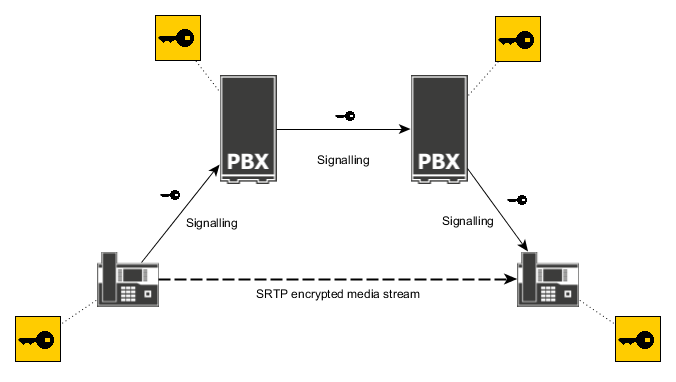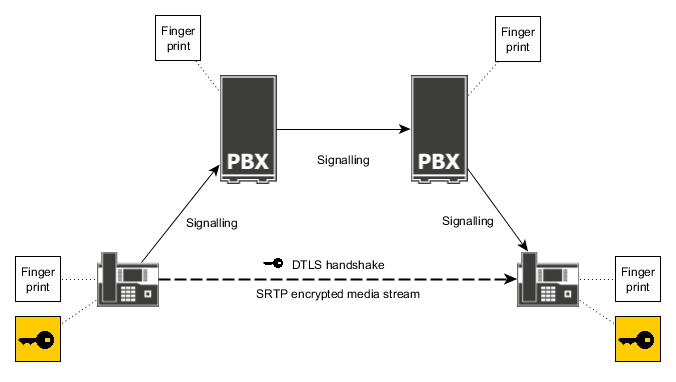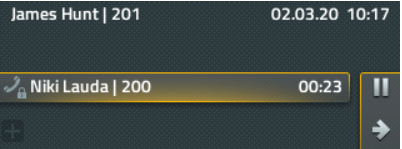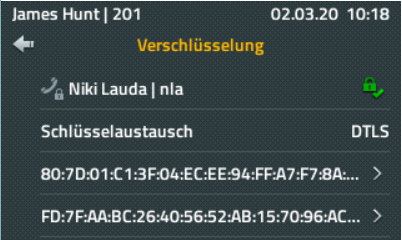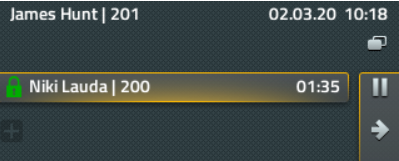Reference13r3:Concept DTLS-SRTP
Applies To
This information applies to
- all innovaphone devices from v13r3
Overview
SRTP is a standard for encrypting RTP media streams. Before two endpoints can do that encryption they need to exchange secret keys. DTLS-SRTP is a new method how to do so.
SDES
In order to understand the advantages of DTLS-SRTP let's go one step back and take a look SDES - the standard key exchange method for SRTP. SDES transmits the secret keys as part of the signalling messages. That messages go from one endpoint over several PBXes to the other endpoint, hop-by-hop. As the secret keys have to be protected from eavesdropping the signalling messages have to be encrypted as well. But the signalling messages are only encrypted hop-by-hop, so each PBX can see or even modify the keys.
It is a design problem of SDES that endpoints have to trust the PBXes. This is a manageable risk when all PBXes are under control of the customer. But with internet calls across company boundaries it becomes an actual threat. Possible attacks include corrupted signalling nodes that give away the keys together with the call details to an attacker that is then capable of decrypting captured SRTP calls on a large scale.
DTLS-SRTP
DTLS-SRTP was designed to solve that issue. It does not transmit the keys in signalling messages but inband as part of the media stream using end-to-end encryption. Before the media stream starts both endpoints perform a mutual DTLS handshake on the media ports. The shared symmetric key that was established for the resulting DTLS session is then used to derive an SRTP key. Then the encrypted SRTP media stream is started.
The protocol does not rely on the trustability of the certificates that are used for DTLS. They are just considered as a container format for the public key of the remote endpoint.
Instead fingerprints are used to allow users for manually checking if the call is encrypted end-to-end. In this context a fingerprint is a hash value calculated over the certificate. Each endpoint sends the fingerprint of its own certificate to the remote party over the signalling. The VOIP stack checks if the remote fingerprint actually matches the certificate that was used for DTLS. If it is not, the call is disconnected right away. Users that need end-to-end encryption can read the fingerprints that are displayed on the phone and compare them to the fingerprints that are displayed on the other phone. If they match, end-to-end-encryption is running for this call. If the fingerprints do not match, it means the call is decrypted and encrypted again somewhere in the middle. For example this happens with media relay, ISDN legs or when there is an actual man-in-the-middle attack.
Pros and cons
At a glance DTLS-SRTP offers the following advantages:
- End-to-end encryption
- Detection of man-in-the-middle attacks
- No need to trust PBXes
- No need to trust certification authorities
On the other hand there are also some negative aspects:
- Adds an additional delay at the begin of calls
- Causes significantly higher CPU load at the begin of calls
- Less SRTP Cipher available, what means lower encryption level on the Media compared to SDES that could have a SRTP Cipher with AES 256/80.
Configuration
Priority of SDES and DTLS-SRTP
If nothing is configured, the device offers both SDES and DTLS-SRTP for outgoing calls. For incoming calls it selects DTLS if offered. Otherwise it selects SDES or unencrypted RTP, as a fall-back. This allows for compatibility with most endpoints.
The admin can change that behaviour at the configuration of the registration or interface. There the key exchange mechanisms (SDES, DTLS-SRTP) and their priority can be selected. For example on phones this can be done on page Phone/User/General. Please consult the help pages for details.
Certificates
No special configuration is needed regarding certificates. DTLS-SRTP does not require endpoints to have the certificate of the remote endpoint in the trust list. Also it doesn't check the names inside certificates.
Proof of secure connection
Conversations may be routed via several hops.
If the call is encrypted with SDES / SDES-DTLS only, the keys are included in the signalling - but each hop would be able to read them. The endpoint therefore does not know whether there is a real end-to-end encryption.
Use of DTLS or at least DTLS-SDES eliminates the possibility for hops to read the keys.
However, there is one exception: If between the endpoints there's a a hop doing MediaRelay, RTP and thus the keys could be read and changed there.
Therefore one can see on the phone how and especially with which keys a call is transmitted.
For this the phone must always do DTLS or at least alternatively DTLS-SDES.
When a call is active, the local / remote keys used can be checked via the callscreen (opening the call on the callscreen) and compared verbally.
If these match, the call is end-to-end encrypted (without man-in-the-middle) and can be marked as such by clicking on the green lock symbol.
Important: this can only be done manually using the 4-eye-principle - an automatic check would of course take away any basis for the security aspect!
Tracing
Activation
Traces for debugging DTLS-SRTP can be activated at the signalling module. The trace flags are also available on the debug.xml page.
config add H323 /dtls-trace on config add SIP /dtls-trace on config add TSIP /dtls-trace on config add SIPS /dtls-trace on
Reading traces
When creating an offer for a call DTLS-SRTP is initialized for both SRTP and SRTCP. The Initialized lines show the local fingerprints.
DTLS.SRTP.0: Initialize DTLS.SRTP.0: Initialized fingerprint=447af6c5cfe3b66cf0901d9143f6824d4c5d0ba2ee8bd9d0ed9b9f69680277d0 DTLS.SRTCP.0: Initialize DTLS.SRTCP.0: Initialized fingerprint=447af6c5cfe3b66cf0901d9143f6824d4c5d0ba2ee8bd9d0ed9b9f69680277d0
If DTLS is selected as the key exchange mechanism by the signalling protocol, DTLS is connected in the client or server role. A successful connection flow starts with the Connect line that shows the local role and the remote fingerprint. It is followed by a sequence of sent and received messages. When the connection was established successfully, the trace shows a Connected line followed by a Use SRTP line that shows the negotiated cipher suite.
DTLS.SRTP.0: Connect CLIENT options=4 fingerprint=447af6c5cfe3b66cf0901d9143f6824d4c5d0ba2ee8bd9d0ed9b9f69680277d0 DTLS.SRTP.0: Add ClientHello extension "use_srtp" (AES_CM_128_HMAC_SHA1_80, AES_CM_128_HMAC_SHA1_32, no MKI) DTLS.SRTP.0: Write ClientHello DTLS.SRTCP.0: Connect CLIENT options=4 fingerprint=447af6c5cfe3b66cf0901d9143f6824d4c5d0ba2ee8bd9d0ed9b9f69680277d0 DTLS.SRTP.0: Read HelloVerifyRequest DTLS.SRTP.0: Write ClientHello DTLS.SRTP.0: Read ServerHello DTLS.SRTP.0: Read ServerHello extension "use_srtp" DTLS.SRTP.0: Read Certificate DTLS.SRTP.0: Read CertificateRequest DTLS.SRTP.0: Read ServerHelloDone DTLS.SRTP.0: Write Certificate DTLS.SRTP.0: Calculate ClientKeyExchange DTLS.SRTP.0: Write ClientKeyExchange DTLS.SRTP.0: Sign CertificateVerify DTLS.SRTP.0: Write CertificateVerify DTLS.SRTP.0: Write ChangeCipherSpec DTLS.SRTP.0: Write Finished DTLS.SRTP.0: Buffer ChangeCipherSpec DTLS.SRTP.0: Buffer handshake message of next epoch 1 DTLS.SRTP.0: Read ChangeCipherSpec DTLS.SRTP.0: Read Finished DTLS.SRTP.0: Store session e1a6cafeadcae22a79eef9994613114a000fed7400000001 DTLS.SRTP.0: Connected DTLS.SRTCP.0: Unpause DTLS.SRTCP.0: Add ClientHello extension "use_srtp" (AES_CM_128_HMAC_SHA1_80, AES_CM_128_HMAC_SHA1_32, no MKI) DTLS.SRTCP.0: Try resume session e1a6cafeadcae22a79eef9994613114a000fed7400000001 DTLS.SRTCP.0: Write ClientHello DTLS.SRTP.0: Use SRTP "AES_CM_128_HMAC_SHA1_80" DTLS.SRTCP.0: Read HelloVerifyRequest DTLS.SRTCP.0: Write ClientHello DTLS.SRTCP.0: Buffer ChangeCipherSpec DTLS.SRTCP.0: Buffer handshake message of next epoch 1 DTLS.SRTCP.0: Read ServerHello DTLS.SRTCP.0: Read ServerHello extension "use_srtp" DTLS.SRTCP.0: Resume session e1a6cafeadcae22a79eef9994613114a000fed7400000001 DTLS.SRTCP.0: Read ChangeCipherSpec DTLS.SRTCP.0: Read Finished DTLS.SRTCP.0: Write ChangeCipherSpec DTLS.SRTCP.0: Write Finished DTLS.SRTCP.0: Connected DTLS.SRTCP.0: Use SRTP "AES_CM_128_HMAC_SHA1_80"
There are some trailing Timeout and Ignore record lines. They reflect retransmissions that are done to be robust to packet loss and can be ignored.
DTLS.SRTCP.0: Timeout DTLS.SRTP.0: Ignore record (unexpected epoch 0)
If the connection fails for some reason the trace shows an error followed by a Close line.
DTLS.SRTP.0: Disconnect (fingerprint mismatch) DTLS.SRTP.0: Close error=4
Specifications
Fingerprints
innovaphone devices create SHA256 fingerprints. But from remote parties innovaphone devices also accept the following fingerprint types:
- MD5
- SHA1
- SHA224
- SHA256
- SHA384
- SHA512
SRTP cipher suites
The following cipher suites are supported with DTLS-SRTP:
- SRTP_AES128_CM_HMAC_SHA1_80 (preferred)
- SRTP_AES128_CM_HMAC_SHA1_32
Unencrypted RTP is never negotiated using DTLS-SRTP.
References
- RFC5764 - Datagram Transport Layer Security (DTLS) Extension to Establish Keys for the Secure Real-time Transport Protocol (SRTP)
